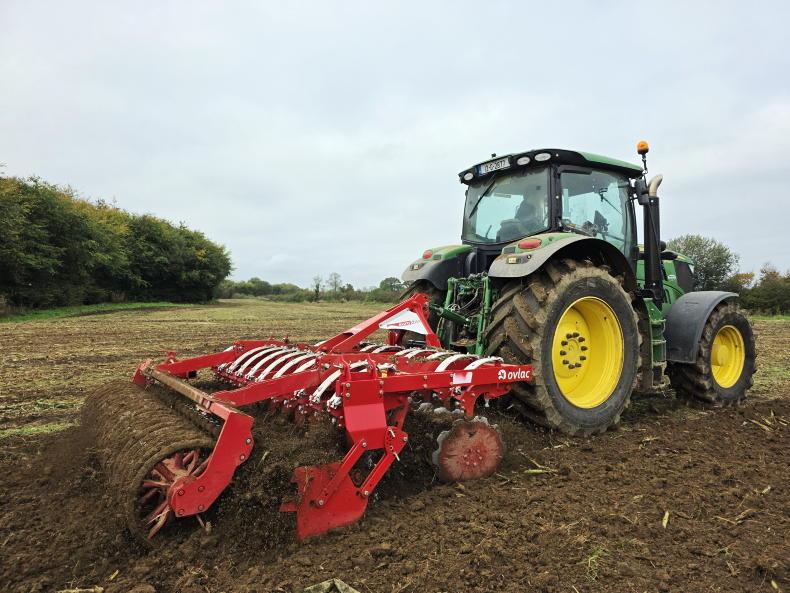With little sign of fertiliser prices returning to more affordable levels, it is crucial grazing swards are productive.
This ensures that where fertiliser is spread, even at reduced rates compared with previous years, grass growth will give an economic response.
Like all aspects of farming, reseeding will be more expensive this year, so consider some of the outlined tips when establishing new grass.
1. Lime and fertiliser
When reseeding swards during July and August that have been grazed since spring, there is little point in soil sampling now as the results will be distorted.
Assume soils are low in lime, phosphorous (P) and potash (K). Apply 1t to 2t/acre of lime - it will be money well spent, especially when stitching in grass seed.
Slurry or dung will help get P and K into the seedbed, as will chemical fertiliser, but this comes at a higher price.
Soil samples can be taken in early winter, six to eight weeks after grazing finishes and the last of the slurry tanks have been emptied.
2. Burning off the old grass
Burning off the existing sward is recommended before ploughing and particularly when stitching in grass seed.
Don’t rush reseeding after spraying. If there is a heavy presence of weeds, such as thistle and docks, it can take 12 to 14 days to get a good kill down to root level.
Grazing off the dead grass cuts down on trash, which makes the seed bed acidic and hinders germination.
3. Fix drainage or compaction problems first
If a sward struggles to grow grass, think about why there is a problem. There are loads of older swards with high levels of ryegrass and clover that yield well.
Therefore, is soil compaction or poor drainage the reason grass growth struggles every year?
Dig a few holes in the field down to 15in or 18in. If grass roots are confined to the top few inches or soil is compressed with horizontal plates, then compaction is a problem that has to be addressed.
Ploughing will open up the soil. But for a stitched-in reseed, sub-soiling is recommended, otherwise the new grass will also struggle to grow.
4. Choosing the right grass seed
Swards that are grazed should have diploid grasses included, as they tiller out, giving a dense sward that is less prone to poaching. Timothy is worth considering on heavier soils.
Cutting swards are better suited to tetraploid grasses, which give high yields, as well as growing tall and erect. But they are very open.
Including 1kg to 2kg of white clover is plenty for grazing swards. Red clover suits silage swards better and include at a rate of 3kg/acre.
Small-leaf clovers suit grazing with sheep, medium-sized clover suit cattle and large varieties suit silage systems.
Finally, pay attention to heading dates and growth potential during spring and autumn.
5. Management of the reseed
New grass can be hungry for nutrients, so feed P to encourage root development. Potash will also help the new sward. Roll lightly after sowing out grass seed to conserve soil moisture.
Ideally, a reseed should be grazed in the first year to encourage tillering out. Weeds will be less of an issue with a summer reseed compared with sowing grass out in May.
Grazing will help to control some weeds without spraying. A post-emergence spray will hit clover seedlings, so reseeding and stitching clover in at a later date may be an option, but is less practical.
Read more
Is there a margin in finishing cattle off grass?
Dairy management: how to look after clover seedlings
With little sign of fertiliser prices returning to more affordable levels, it is crucial grazing swards are productive.
This ensures that where fertiliser is spread, even at reduced rates compared with previous years, grass growth will give an economic response.
Like all aspects of farming, reseeding will be more expensive this year, so consider some of the outlined tips when establishing new grass.
1. Lime and fertiliser
When reseeding swards during July and August that have been grazed since spring, there is little point in soil sampling now as the results will be distorted.
Assume soils are low in lime, phosphorous (P) and potash (K). Apply 1t to 2t/acre of lime - it will be money well spent, especially when stitching in grass seed.
Slurry or dung will help get P and K into the seedbed, as will chemical fertiliser, but this comes at a higher price.
Soil samples can be taken in early winter, six to eight weeks after grazing finishes and the last of the slurry tanks have been emptied.
2. Burning off the old grass
Burning off the existing sward is recommended before ploughing and particularly when stitching in grass seed.
Don’t rush reseeding after spraying. If there is a heavy presence of weeds, such as thistle and docks, it can take 12 to 14 days to get a good kill down to root level.
Grazing off the dead grass cuts down on trash, which makes the seed bed acidic and hinders germination.
3. Fix drainage or compaction problems first
If a sward struggles to grow grass, think about why there is a problem. There are loads of older swards with high levels of ryegrass and clover that yield well.
Therefore, is soil compaction or poor drainage the reason grass growth struggles every year?
Dig a few holes in the field down to 15in or 18in. If grass roots are confined to the top few inches or soil is compressed with horizontal plates, then compaction is a problem that has to be addressed.
Ploughing will open up the soil. But for a stitched-in reseed, sub-soiling is recommended, otherwise the new grass will also struggle to grow.
4. Choosing the right grass seed
Swards that are grazed should have diploid grasses included, as they tiller out, giving a dense sward that is less prone to poaching. Timothy is worth considering on heavier soils.
Cutting swards are better suited to tetraploid grasses, which give high yields, as well as growing tall and erect. But they are very open.
Including 1kg to 2kg of white clover is plenty for grazing swards. Red clover suits silage swards better and include at a rate of 3kg/acre.
Small-leaf clovers suit grazing with sheep, medium-sized clover suit cattle and large varieties suit silage systems.
Finally, pay attention to heading dates and growth potential during spring and autumn.
5. Management of the reseed
New grass can be hungry for nutrients, so feed P to encourage root development. Potash will also help the new sward. Roll lightly after sowing out grass seed to conserve soil moisture.
Ideally, a reseed should be grazed in the first year to encourage tillering out. Weeds will be less of an issue with a summer reseed compared with sowing grass out in May.
Grazing will help to control some weeds without spraying. A post-emergence spray will hit clover seedlings, so reseeding and stitching clover in at a later date may be an option, but is less practical.
Read more
Is there a margin in finishing cattle off grass?
Dairy management: how to look after clover seedlings










SHARING OPTIONS